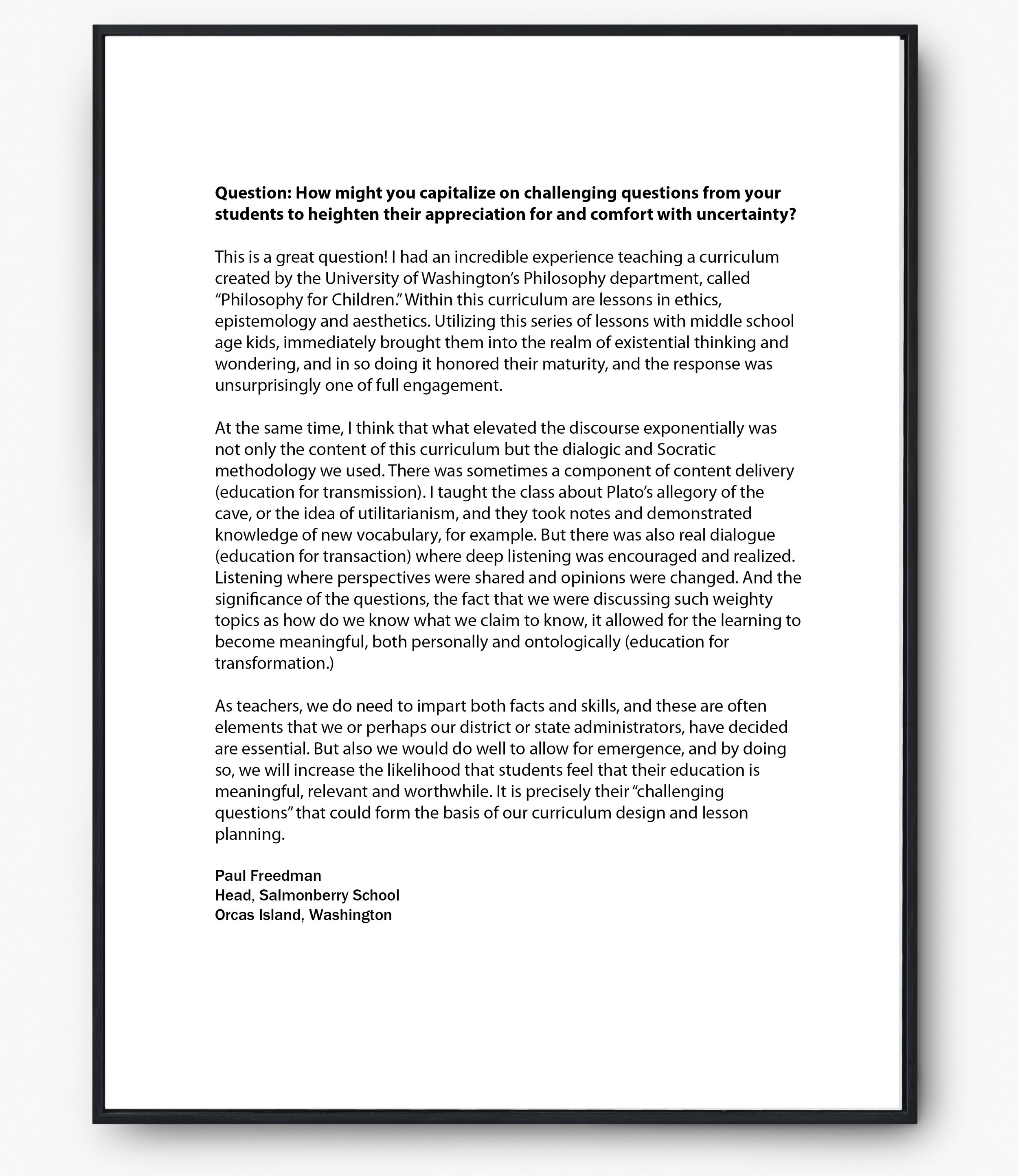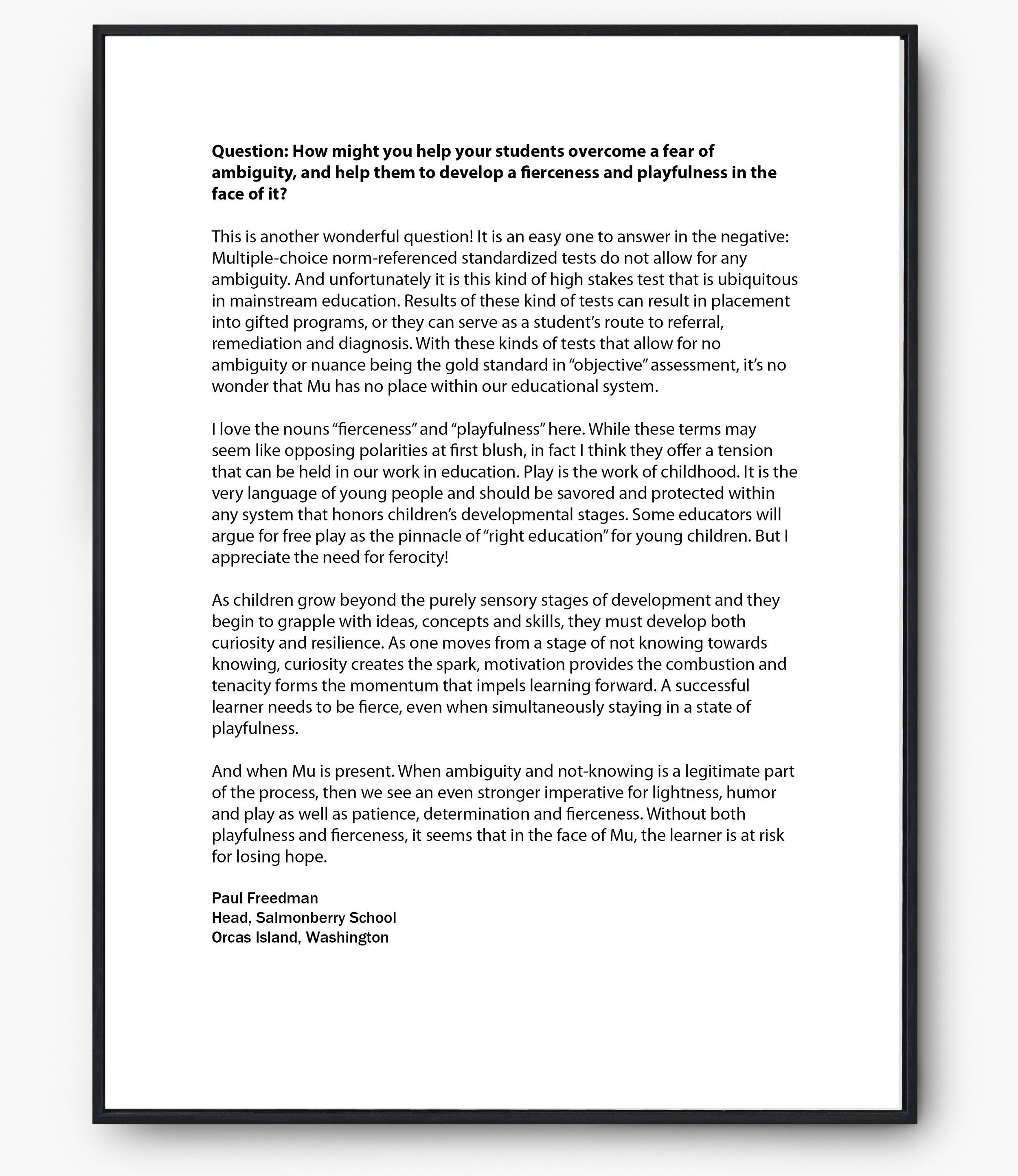Mu
Photo: Joe Gardner via Unsplash
Invention dwells in the land of Mu.
It rejects the leash of Preconception, wanders freely in fields of Ambiguity, and sets sights on the peaks of Neither. If at times it wanders sightless, as if in a fog, still that mind deploys the cunning and sensory perception of the blind.
Walk into any of a hundred thousand classrooms today and hear the teachers divide and subdivide and interrelate and establish "principles" and study "methods" and what you will hear is the ghost of Aristotle speaking down through the centuries-the dessicating lifeless voice of dualistic reason.
(Pirsig, 2006, p. 464)
If what you seek is something new, then enter friends—the land of Mu.
Mu means "no thing." Like "Quality" it points outside the process of dualistic discrimination. Mu simply says, "No class; not one, not zero, not yes, not no." It states that the context of the question is such that a yes or no answer is in error and should not be given. "Unask the question" is what it says.
(Pirsig, 2006, p. 145 of 192)
Zen Buddhism invites you into Mu with the question: “Does a dog have Buddha nature?” It is also the answer to every question you may pose thereafter, until you stop asking them, stop thinking, and begin to exist fully in the moment. Sustaining that state of mind, practicing it, offers a portal to a heightened state of being. Some call it enlightenment.
Three fruits of this practice:
1. A deepening of concentration: the ability to be present in the here and now of each moment.
2. An experience of awakening: not a conceptual realization but an essential deepening of awareness.
3. The potential for “a way of life grounded in peace, sustained by an inner joy, and marked by a sense of wonder and gratitude at every turn” (Habito, 2011, p. 189).
Enlightenment is enticing, but just as important is how Mu strengthens the power of the mind. It offers the ability to take charge of the mental on/off switch, to build a capacity when desired to privilege sensing and feeling over thinking by literally shutting down the endless narratives in your head. The power of this is incalculable.
The irony of suggesting that school teach the capacity to “not-think” is not lost. However, we might recognize that school also teaches the powers of observation and sensation. Mu powerfully augments the capacity to sense and feel by shutting down competing faculties, aligning very nicely with the objectives of education. Enlightenment is a pretty nice perk, but enhancing the vividness of experience is a more immediate consequence that a school devoted to the self-actualization of the child might firmly take to heart.
Escape
Mu also teaches a particular affect or attitude. Confronted with two choices, black or white, the answer “Mu” requires a stubborn allegiance to the radical dream of color. That combination, stubbornness and idealism, is the heart and soul of invention. Strengthening that capacity to reject easy alternatives and follow the slightest inkling of . . . something else . . . is certainly an objective worthy of school.
Not some third way compromise that splits the difference between two radical opposites, not “Grey” when confronted by “Black or White”, Mu rejects the two dimensional premise of the problem and seeks unexplored terrain. Mu privileges Invention over Innovation (Graste, 2012), striking out for something entirely new rather than a more earth-bound focus on incrementalist improvement. (We might ask ourselves, culturally, how this happened, by the way. How did this meek word “Innovation” supplant “Invention”? How have our collective aspirations so shrunk as to leave us moored to earth while the sky beckons? Have we succumbed to a mercantilism that makes us all innovative entrepreneurs instead of ground-breaking inventors? It is a pragmatic prospect, but a disheartening one).
When we seek “groundbreaking” work, is this not the effort of hammering fissures into the frame of reference, of tunneling into a new dimensional perspective? When we champion “blue-sky” thinking, is it not to rise above the frame, ascending into uncharted possibility? Tunnels and bridges, mining and flying, evasion and escape: this is the work of invention.
Oh, I have slipped the surly bonds of earth,
And danced the skies on laughter-silvered wings;
Sunward I've climbed and joined the tumbling mirth of sun-split clouds -
and done a hundred things You have not dreamed of -
wheeled and soared and swung high in the sunlit silence.
Hovering there I've chased the shouting wind along
and flung my eager craft through footless halls of air.
"Up, up the long delirious burning blue
I've topped the wind-swept heights with easy grace,
where never lark, or even eagle, flew;
and, while with silent, lifting mind I've trod
the high untrespassed sanctity of space,
put out my hand and touched the face of God.
High Flight
John Gillespie Magee, Jr.
But the mechanisms of control are many and devious.
Containment
How often do we offer “Rules of Thumb”, for example? Offering a well-travelled trail to avoid a less certain and more arduous bushwack will lead you nowhere new; there are no trails in the land of Mu. This is how we reinforce a frame, not how we escape it.
How often do we punish refusal? A traveler to Mu must refuse, must deny, must contradict to survive. They must say “No” to your easy constraints and choices. To be free is to be fierce. How does that sound to a teacher vested in some modicum of control? How does it play in a system tuned more to accountability than self-realization?
Nonetheless, we aspire to invention; to preparing students to become inventors!
Invention is escape: escape from the expected, escape from the assumed, escape from the understood. If school aspires to certainty, then how is it preparing students for the unknown? To know is so…reassuring. To know is to be at peace. It foregoes restlessness, eschews change, and embraces the fantasy of certainty. To “know” therefore is to lie. Better to dedicate ourselves to “possibility”.
Question: Certainty and possibility: how do you handle them in your lesson plans?
Question: How might you capitalize on challenging questions from your students to heighten their appreciation for and comfort with uncertainty?
Question: How might you help your students overcome a fear of ambiguity, and help them to develop a fierceness and playfulness in the face of it?
How often do we say or hear: “Understand the rules before you break them”? While a persuasive justification for education, it reeks of command and control. Lock yourselves in these prisons of constraint, so that you may afterwards escape? How many actually make it out alive? Would the uncaged animal not range more freely, travel further, and discover more? Would she not meet the obstacles on her journey, one by one, as a matter of course instead of some frenzy in a bid for freedom?
My classroom is not a prison, you protest, but an egg! In it, the child grows in strength and capacity until it smashes the shell, ready to take on the world! This is Erikson’s moratorium, in which the child experiments freely in order to find or define an identity. Perhaps so, but if that egg is to prime for invention than it will encourage rule-transcending instead of rule-following. It will focus on exceptions and dissidents, and it will privilege humor and the unexpected. What better way to learn the rules, than by dodging them?
Question: Order is highly prized in the classroom. How might you invite rule-transcending without inviting utter chaos?
Transcendence
It is, perhaps, a radical exhortation to privilege rule-transcending, but only if we fail to distinguish it from rule-breaking. Mu does not break rules, it merely defies expectation. Neither following nor breaking, it steps into another dimension. It embraces Paradox.
“Paradox is every idea, or better, every expression of ideas that departs from common sense. “Para-“ means deviation, what lies outside; ”doxa” means opinion. All right, so it is what goes against common sense… Not against, for then it would be antidoxa and not paradoxa; it is not what goes against the strong mainstream [of common opinion] but what diverges from it” (Gotz, 2002, p. 17)
Thus Mu is not confrontational in the conventional sense. Black or white, one or zero, yes or no: these are all oppositions or dialectics. Bringing them together need not be combustible however. It may just be an invitation to negotiate. As Barbara Montgomery pointed out in a 1993 paper, negotiating oppositions is the stuff of relationships. She proposed three kinds of oppositions (Montgomery, 1993, p. 205-223):
(1) oppositions that are mutually exclusive and exhaustive (e.g., openness versus non-openness)
(2) oppositions that are mutually exclusive but not exhaustive (e.g., connection versus autonomy)
(3) oppositions that are complementary (e.g., dominance versus submissiveness)
From this classification we begin to understand dialectics not as all-or-nothing, one extreme or the other, and not necessarily as a combustive clash of thesis and antithesis yielding some revolutionary synthesis, but as a relationship constantly shaped by negotiation. From this perspective, Mu is a conversation rather than a decision, something alive in the relationship rather than something defining its boundaries.
Question: Does this idea change how you might manage rule-transcending in your classroom?
Rules vs. Assumptions
Operationally, Mu often finds and challenges the assumptions among the rules. Thus it finds weaknesses in the web of constraints, and expands the boundaries of operation without breaking the rules. For example, the rule “a representation of this person shall be made using this paper and this charcoal” could be exercised conventionally by drawing on the paper, or more unconventionally by lighting the charcoal on fire to burn an image into the paper, or even more radically by soaking the paper in white glue, and forming it over the model’s face. Covering the face with charcoal beforehand will keep the paper from sticking as it dries. Each of these operations might exquisitely meet the brief, but only the latter two depart from expectation without breaking the rules. We might call an exquisite portrait: Craft. We might call a representation that subverts expectation: Art.
Forming that paper, the third example, is instructive in that it brings meaning to that white sheet of paper not by marking it up, but by departing from the two dimensional frame and unfurling it into a third dimension. This dimensional shift is a particularly useful strategy in Mu.
This distinction, between creating within the assumptions and creating outside them, between innovation and invention, is a particularly poignant one in light of a famous quote attributed to Albert Einstein:
“No problem can be solved from the same level of consciousness that created it”.
Albert Einstein
If sometimes our problems as a civilization appear more and more intractable and existential, we might take some solace in a trip to Mu. Changing the level of consciousness, identifying and upending assumptions, flying and subverting, bridging and tunneling: these are the adventures you’ll find there.
References
Gotz, I. L. (2002). Faith, Humor and Paradox. Greenwood. [quoting M. de Unamuno].
Graste, T. (2012) The difference between invention and innovation. [Blog post]. http://mediashift.org/2012/03/the-difference-between-invention-and-innovation086/
Habito, Ruben L.F. (2011). Practicing Mu, Arriving Home, in J. I. Ford & M. M. Blacker (Eds.), the book of MU. Wisdom.
Magee, Jr., J. G. (1941). High Flight. [public domain] https://en.wikisource.org/wiki/High_Flight
Montgomery, B. M. (1993, May 1), Relationship Maintenance versus Relationship Change: A Dialectical Dilemma. Journal of Social and Personal Relationships. 10(2).
Pirsig, R. (2006). Zen and the Art of Motorcycle Maintenance. HarperCollins. (Original work published 1974).
Your thoughts on this journal post are highly valued, as I continue to build and refine my perspective on schools and the school environment. Please share your own experiences and perceptions of the school environment below!





